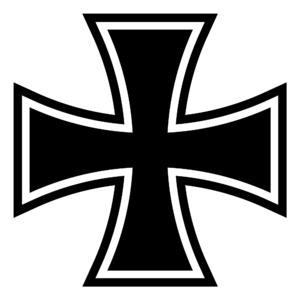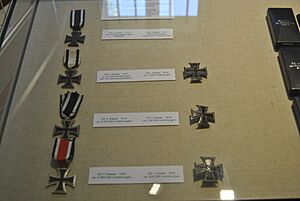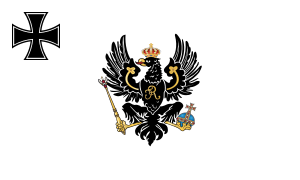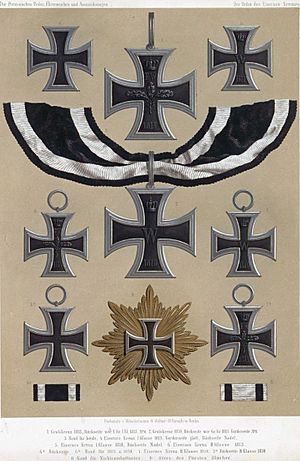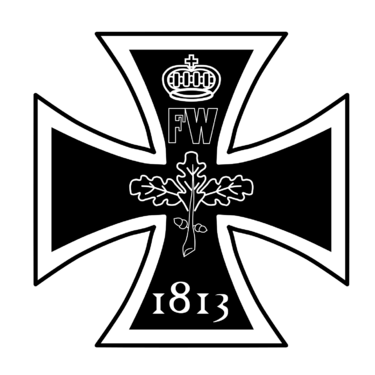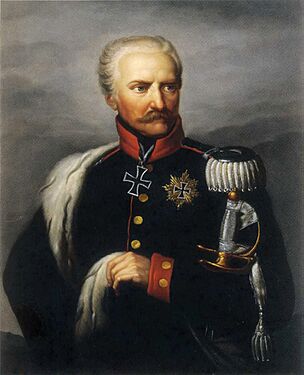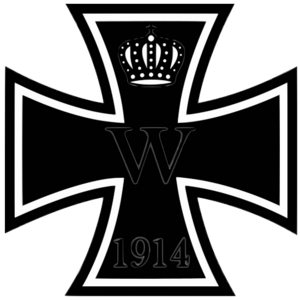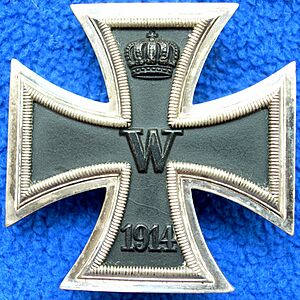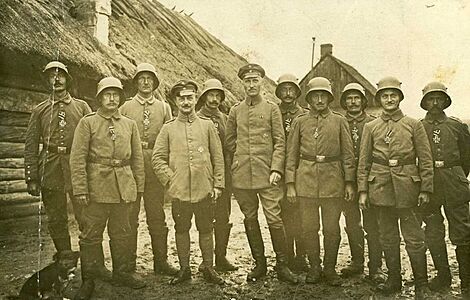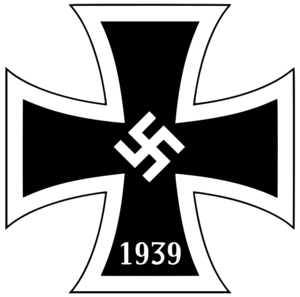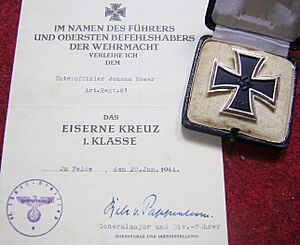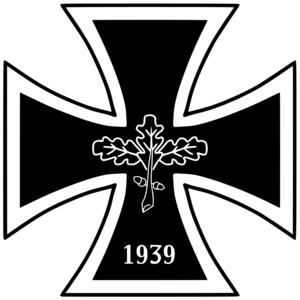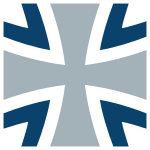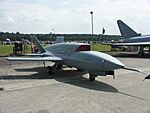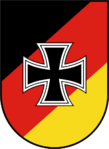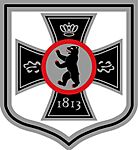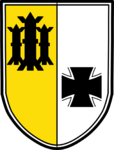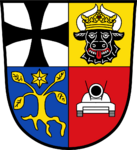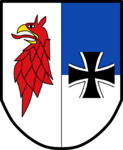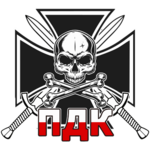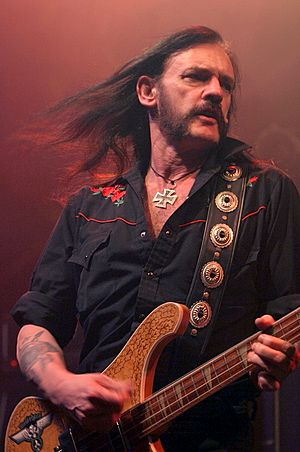Iron Cross facts for kids
The Iron Cross (called Eisernes Kreuz in German) was a special military award in Germany for a long time. It was first used in the Kingdom of Prussia, then in the German Empire, and later in Nazi Germany.
The design of the Iron Cross is a black cross with a white or silver outline. This design comes from the Teutonic Order, a group of knights from the Middle Ages. Besides being a medal, the Iron Cross has also been used as a symbol by the German army for many years. Today, it is the symbol of the Bundeswehr, which is Germany's modern army.
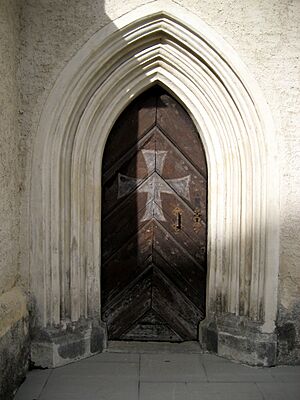
King Frederick William III of Prussia created the Iron Cross award on March 17, 1813, during the Napoleonic Wars. He made the award's start date March 10, which was his late wife Queen Louise's birthday. She was the first person to receive it, after she had passed away.
The Iron Cross was also given out during the Franco-Prussian War, World War I, and World War II. During World War II, the Nazi government added a swastika symbol to their version of the medal.
Usually, the Iron Cross was only for soldiers. However, a few civilians received it for doing military jobs, like Hanna Reitsch and Melitta Schenk Gräfin von Stauffenberg. They were civilian test pilots during World War II.
Since the late 1900s, the Iron Cross symbol has also been used by some motorcycle clubs and in heavy metal fashion.
The Black Cross Symbol
The Black Cross (Schwarzes Kreuz) is a symbol used by the Prussian Army and Germany's army from 1871 until today. It was designed when the Iron Cross medal was created in 1813. This was the first military award open to all soldiers, no matter their rank.
From that time, the Black Cross appeared on the Prussian war flag. It was designed by an architect named Karl Friedrich Schinkel. The design came from the black cross used by the Teutonic Order knights.
The Black Cross was used on the naval and combat flags of the German Empire. It was the German Army's symbol until 1915, when a simpler cross called the Balkenkreuz took its place. The armies of the Weimar Republic and Nazi Germany also used this symbol. Today, the Bundeswehr (Germany's modern army) still uses the Black Cross in different ways.
Medal and Ribbon Design
The ribbon for the 1813, 1870, and 1914 Iron Cross (2nd Class) was black with two thin white stripes. These were the colors of Prussia. For those who received the award for non-combat roles, the black and white colors on the ribbon were swapped. The ribbon for the 1939 Iron Cross (2nd Class) was black, white, red, white, and black.
Since the Iron Cross was given out during different periods, each medal had the year it was issued. For example, an Iron Cross from World War I has "1914" on it, while one from World War II has "1939". The back of the 1870, 1914, and 1939 Iron Crosses shows the year "1813". This reminds everyone when the award was first created.
The 1813 medal also had the initials "FW" for King Friedrich Wilhelm III. The next two versions had a "W" for the emperors Wilhelm I and Wilhelm II. The last version from World War II had a swastika symbol instead of a letter. After World War II, a "1957" version was made for those who had the 1939 medal. This new version replaced the swastika with an oak-leaf design.
If someone had already received an Iron Cross in 1870 and then earned another in 1914, they could wear a special clasp. This clasp had a small 1914 Iron Cross on a metal bar. In World War II, if someone had a 1914 Iron Cross and earned a 1939 one, they would wear a "1939 Clasp" on their original 1914 medal.
Wars of Liberation
On March 17, 1813, King Frederick William III of Prussia created the Iron Cross. It was given to soldiers during the Wars of Liberation against Napoleon. To receive the Iron Cross 1st Class, a soldier first needed to have the Iron Cross 2nd Class. The first person to receive the Iron Cross 1st Class was Karl August Ferdinand von Borcke on April 21, 1813.
-
King Frederick William III of Prussia, who created the award
-
Field Marshal Blücher wearing the 1813 Grand Cross of the Iron Cross
Franco-Prussian War
King Wilhelm I of Prussia allowed more Iron Cross awards on July 19, 1870, during the Franco-Prussian War. Soldiers who received the 1870 Iron Cross and were still serving in 1895 could buy and wear a "Jubilee clip." This clip had the numbers "25" on three oak leaves, marking 25 years.
William Manley might be the only person to receive both the Iron Cross and the Victoria Cross. He earned the Iron Cross for his work with an ambulance unit in the Franco-Prussian War.
World War I
Emperor Wilhelm II brought back the Iron Cross on August 5, 1914, at the start of World War I. During these times, the Iron Cross was an award from Prussia. However, because Prussia was so important in the German Empire, it was seen as a general German award. The 1813, 1870, and 1914 Iron Crosses had three levels:
- Iron Cross, 2nd Class (EKII)
- Iron Cross, 1st Class (EKI)
- Grand Cross of the Iron Cross (often called Großkreuz)
Even though the front of the medals looked the same for each level, they were worn differently. The Iron Cross, 1st Class, had a pin on the back and was worn on the left side of the uniform. The Iron Cross 2nd Class and the larger Grand Cross hung from ribbons. The Grand Cross was worn around the neck, and the 2nd Class was worn from a ribbon through a buttonhole on the uniform.
The Grand Cross was meant for high-ranking generals. An even higher award, the Star of the Grand Cross of the Iron Cross (also called the Blücher Star), was given only twice. It went to Field Marshal Gebhard Leberecht von Blücher in 1813 and Field Marshal Paul von Hindenburg in 1918.
The Iron Cross, 1st Class, and 2nd Class, were given to soldiers of any rank. To get the 1st Class, you usually had to have the 2nd Class first. This was different from many other awards in Europe, which were often given based on a soldier's rank. Even though the Iron Cross was for all ranks, officers and non-commissioned officers (NCOs) were more likely to receive it than junior soldiers.
During World War I, about 218,000 Iron Cross 1st Class medals and over 5 million Iron Cross 2nd Class medals were awarded. Many awards were given, which made the decoration less special. One famous person who received the 1914 Iron Cross, 2nd Class, and 1st Class, was Adolf Hitler. He earned these medals for bravery in battle while serving as a lance-corporal in the Bavarian Army.
World War II
Adolf Hitler brought back the Iron Cross in 1939 as a German award, not just a Prussian one. It still had different levels. The ribbon for the 2nd Class and Knight's Cross was different from earlier Iron Crosses. It used red along with the traditional black and white. Black and white were the colors of Prussia, while black, white, and red were the colors of Nazi Germany. Hitler also created the War Merit Cross for non-combat roles.
Iron Cross (1939)
The standard 1939 Iron Cross had two main levels:
- Iron Cross, 2nd Class (EK II)
- Iron Cross, 1st Class (EK I)
The Iron Cross was given for bravery in battle and other important military actions.
The Iron Cross, 2nd Class, came with a ribbon. Soldiers could wear the ribbon through the second buttonhole of their uniform for everyday wear. For formal events, the whole cross could be worn.
The Iron Cross, 1st Class, was a medal with a pin on the back. It was worn in the middle of the uniform's left chest pocket. To get the 1st Class, a soldier usually had to earn the 2nd Class first.
It's thought that about 4.5 million 2nd Class Iron Crosses and 300,000 1st Class Iron Crosses were awarded during World War II.
Many women, mostly nurses from the German Red Cross, received the Iron Cross 2nd Class for their bravery. Two women, test pilot Hanna Reitsch and German Red Cross sister Else Grossmann, also received the Iron Cross 1st Class.
Knight's Cross of the Iron Cross
The Knight's Cross of the Iron Cross (Ritterkreuz) was given for great military bravery or successful leadership. It had five different levels:
- Knight's Cross
- Knight's Cross with Oak Leaves
- Knight's Cross with Oak Leaves and Swords
- Knight's Cross with Oak Leaves, Swords, and Diamonds
- Knight's Cross with Golden Oak Leaves, Swords, and Diamonds
In total, 7,313 Knight's Crosses were awarded. Only one person, Oberst Hans-Ulrich Rudel, received the highest level: the Knight's Cross with Golden Oak Leaves, Swords, and Diamonds.
Grand Cross of the Iron Cross (1939)
Like the Knight's Cross, the Grand Cross (Großkreuz) was worn around the neck. It was given to high-ranking generals for "the most important strategic decisions that changed the war." The only person to receive it during World War II was Reichsmarschall Hermann Göring. He received it on July 19, 1940, for leading the Luftwaffe (German air force) after the Battle of France.
This medal was a larger version of the Knight's Cross. It was originally planned to have gold edges, but this was changed to silver before it was given out. It was worn with a wide ribbon that had the same colors as the Knight's Cross and 2nd Class ribbons.
Star of the Grand Cross of the Iron Cross
The Star of the Grand Cross of the Iron Cross was pinned to the left chest, above the Iron Cross 1st Class. Like the Grand Cross, it was for very successful generals.
This star was only awarded twice. In 1815, it went to Gebhard Leberecht von Blücher for his role in the Battle of Waterloo. In March 1918, it went to Paul von Hindenburg for his actions in the 1918 Spring Offensive on the Western Front. It is often called the Blücher Star after its first recipient.
A Star of the Grand Cross was made during World War II, but it was never officially given out. The only known example is now in a museum at West Point. It is thought that Reichsmarschall Göring was meant to receive it.
Post-World War II
After World War II, German law made it illegal to produce or display items with Nazi symbols. Because of this, the West German government allowed new Iron Crosses to be made in 1957. These new medals had an oak leaf design instead of the swastika. This was similar to the older Iron Crosses from 1813, 1870, and 1914. World War II Iron Cross recipients could wear these new versions.
After German soldiers started serving in places like Kosovo and Afghanistan, there was a push to bring back the Iron Cross and other military medals. This was because Germany didn't have specific awards for active military service. In 2008, a new award called the Ehrenzeichen der Bundeswehr (Badge of Honor of the German Armed Forces) was created. It doesn't look like the traditional Iron Cross, but it is an important award for the Bundeswehr.
-
The symbol of the Bundeswehr, Germany's modern armed forces
-
The Iron Cross symbol on a Leopard 2 main battle tank
Biker and Heavy Metal Subcultures
In the United States, some outlaw motorcycle clubs started using the Iron Cross in the 1960s. They used it as a symbol of rebellion. From biker culture, it spread to rock and heavy metal music. It became a part of heavy metal fashion. Lemmy Kilmister from the band Motörhead often wore an Iron Cross necklace.
In the 1990s, this use of the Iron Cross also spread to skateboarders and extreme sports fans. It became part of the logos for some clothing companies. The Anti-Defamation League says that the version of the symbol with a swastika has been used by neo-Nazis as a hate symbol. However, the wider use of the Iron Cross in different groups means that whether it's a hate symbol depends on how it's used. If it's just the Iron Cross by itself, without a swastika or other hate symbols, it's not considered a hate symbol.
Gallery of Medal Ribbons
| Iron Cross 2nd Class | ||||
|---|---|---|---|---|
| Iron Cross, 2nd Class, 1813–1913 | Iron Cross, 2nd Class, for Non-combatants 1813–1918 | EK II 1914, with 1939 clasp | EK II 1914–1939 | EK II 1939–1945 |
| Iron Cross 1st Class | |||
|---|---|---|---|
| Iron Cross, 1st Class, 1813–1913 | EK I 1914, with repetition 1939 | EK I 1914–39 | EK I 1939–45 |
| Knight's Cross of the Iron Cross | ||||
|---|---|---|---|---|
|
Knight's Cross Alternative version |
... with Oak Leaves Alternative version |
... and Swords Alternative version |
... and Diamonds Alternative version |
...in Gold ... Alternative version |
| Grand Cross of the Iron Cross | |
|---|---|
| Grand Cross to the Iron Cross | Star of the Grand Cross (Iron Cross) |
See also
 In Spanish: Cruz de Hierro para niños
In Spanish: Cruz de Hierro para niños
- Grand Cross of the Iron Cross
- Star of the Grand Cross of the Iron Cross
- Knight's Cross of the Iron Cross
- 1939 Clasp to the 1914 Iron Cross
- Black Cross (Teutonic Order)
- Cross pattée
- Cross of the Warsaw Uprising (Krzyż Powstania Warszawskiego)
- Oxalis tetraphylla (a common name is Iron Cross)


